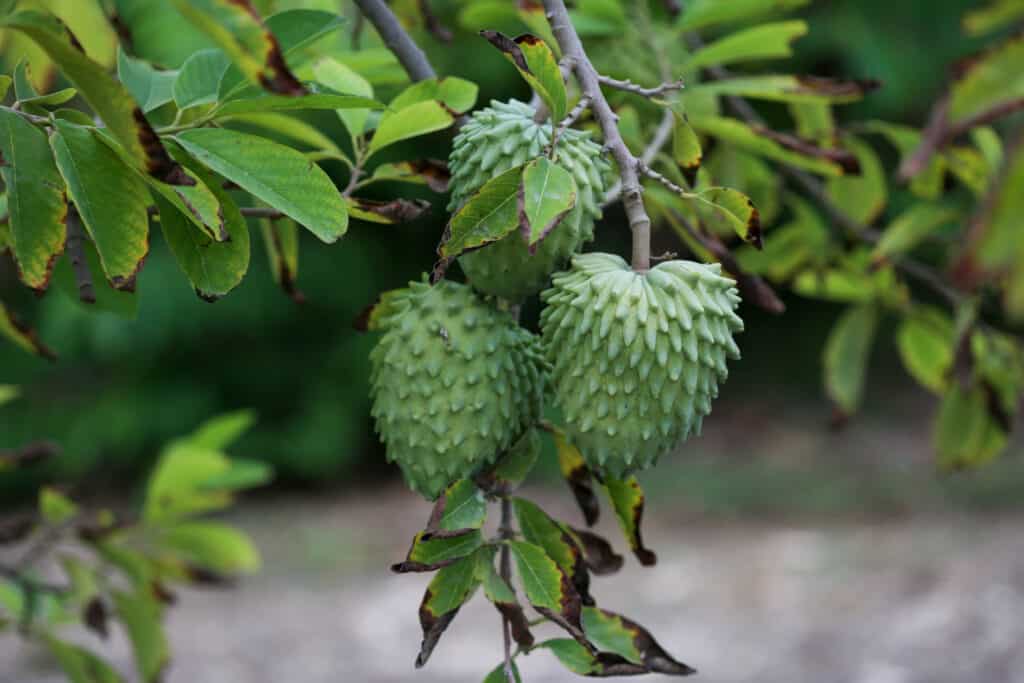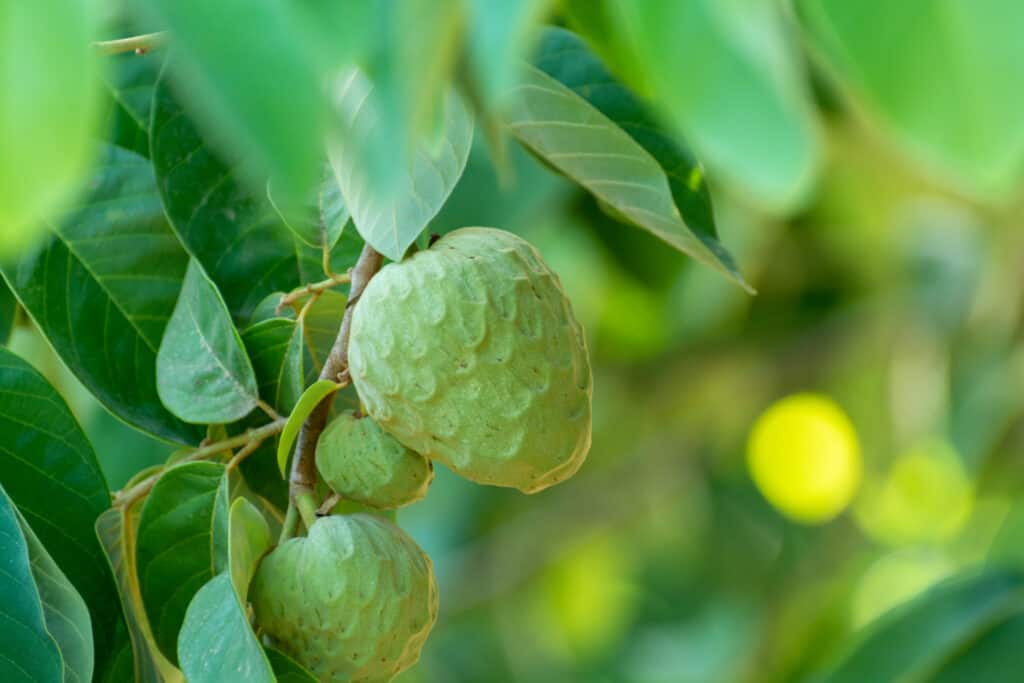Have you ever wandered past the tropical or exotic fruit selection at your local grocery store and wondered what all those colorful fruits were? Some have unusual skin or some spikey portions, and all have bright, brilliant colors.
This article will offer insight into two lovely tropical fruits — atemoya (Annona × atemoya) and cherimoya (Annona cherimola). You will learn how they are similar and a handful of their unique traits.
Atemoya vs. Cherimoya: Comparison
We have highlighted some of these traits to showcase the differences between atemoya and cherimoya. You will find a chart below that breaks down the distinctions between each fruit.
Both atemoya (Annona × atemoya) and cherimoya (Annona cherimola) belong to the Annonaceae family and Annona genus. This genus boasts roughly 200 unique species, while the Annonaceae family has approximately 2,000 species across 119 genera.
While the two cousins have commonalities, they also have some unique attributes. Some differences include the classification, origin, size, and fruit. Below, we examine each of these attributes in depth.
| Atemoya | Cherimoya | |
|---|---|---|
| Scientific Classification | Annona × atemoya | Annona cherimola |
| Common Name(s) | Atemoya | Cherimoya, custard apple, anona |
| Origins | It is a hybrid of Annona squamosa and Annona cherimola. This tree is not known to grow wild. | This tree is native to Peru, Ecuador, and Colombia. |
| Size | A small tropical tree, atemoya only reaches up to 26 feet at maturity. So it is ideal for backyards with a little room to spare. | This relatively short, deciduous tree reaches 19-32 feet tall. |
| Fruit | The sweet fruit most closely resembles cherimoya. It typically grows between 3 and 6 inches in diameter. Its outer skin is green and spiky. | The green, cone or heart-shaped fruit can grow up to 11 pounds apiece. It has white, juicy, and fragrant flesh. |
| Growing Requirements | Winter hardy in Zones 10-12. This tree is not picky about its soil. However, it grows best in loamy, clay, or sandy, well-draining soil. It also requires full sun. | Grow this tree in Zones 8-12 in well-draining soil. It enjoys clay-based, sandy, or loamy soil. But does not need a ton of nutrition. This drought-tolerant tree needs full sun. |
| Fun Facts | Add the fruit to sorbets, ice creams, or tasty beverages. | The seeds and stems are highly poisonous. Make sure you remove them before eating. |
Atemoya vs. Cherimoya: Scientific Classification
While atemoya and cherimoya come from the same genus, they have one striking difference. Annona × atemoya does not occur in the wild. Instead, it is a hybrid between Annona squamosa and Annona cherimola. Atemoya trees typically require human intervention for further propagation. This step is done through grafting or planting seeds. These stunning fruit trees vary greatly, especially when propagated via seed.
Atemoya vs. Cherimoya: Origin
The USDA developed the atemoya hybrid in a lab in the early 1900s.
But the naturally occurring cherimoya is native to Peru, Ecuador, and Colombia.

Atemoyas are a hybrid fruit.
©AJCespedes/Shutterstock.com
Atemoya vs. Cherimoya: Size
The tree that produces atemoya fruit is small and tropical. At maturity, it will reach up to 26 feet tall. Due to its relatively small stature, it is ideal for the backyard or ornamental gardens.
Cherimoya trees can grow slightly taller. At their smallest, they will only reach 19 feet. But in optimal growing conditions, the trees grow to a maximum of 32 feet. You can still grow it in your backyard. You just may need a little extra space.
Atemoya vs. Cherimoya: Fruit
One of the biggest differences between atemoya and cherimoya is the tasty fruit.
While atemoya fruit more closely resembles A. cherimola than A. squamosa, it developed some very unique characteristics. Its green skin has spikes. Additionally, the fruit is slightly smaller, ranging from 3 to 6 inches in diameter. The creamy inner flesh tastes much like pineapple, only slightly more sour.
However, the cherimoya fruit grows much larger. Typically the fruit is the size of grapefruit but can reach an astounding 11 pounds! Its inner flesh is juicy, white, and highly fragrant. Not many people can agree on its flavor, but all agree that it is an interesting combination of all your favorite tropical fruits.

Cherimoya fruit can grow as large as 11 pounds.
©barmalini/Shutterstock.com
The photo featured at the top of this post is © NIKCOA/Shutterstock.com
Sources
- Plants for a Future, Available here: https://pfaf.org/user/Plant.aspx?LatinName=Annona+cherimola
- Farmer's Almanac, Available here: https://www.farmersalmanac.com/what-the-heck-is-cherimoya-15580
- Plants for a Future, Available here: https://pfaf.org/user/Plant.aspx?LatinName=Annona+atemoya
FAQs (Frequently Asked Questions)
What does atemoya taste like?
Atemoyas have a flavor resembling a slightly sour pineapple or even a pina colada.
How do I know when my atemoya is ripe?
Feel free to dive into this tasty fruit once the skin develops a brown hint and it gives slightly under gentle pressure.
Can you eat cherimoya raw?
Yes, you can eat it raw if you remove the seeds. Alternatively, it makes a marvelous addition to several sweet and savory dishes.
What month is cherimoya in season?
You will typically find cherimoya in season starting in November. Its season lasts until spring, but the availability depends on the weather.
Thank you for reading! Have some feedback for us? Contact the AZ Animals editorial team.






